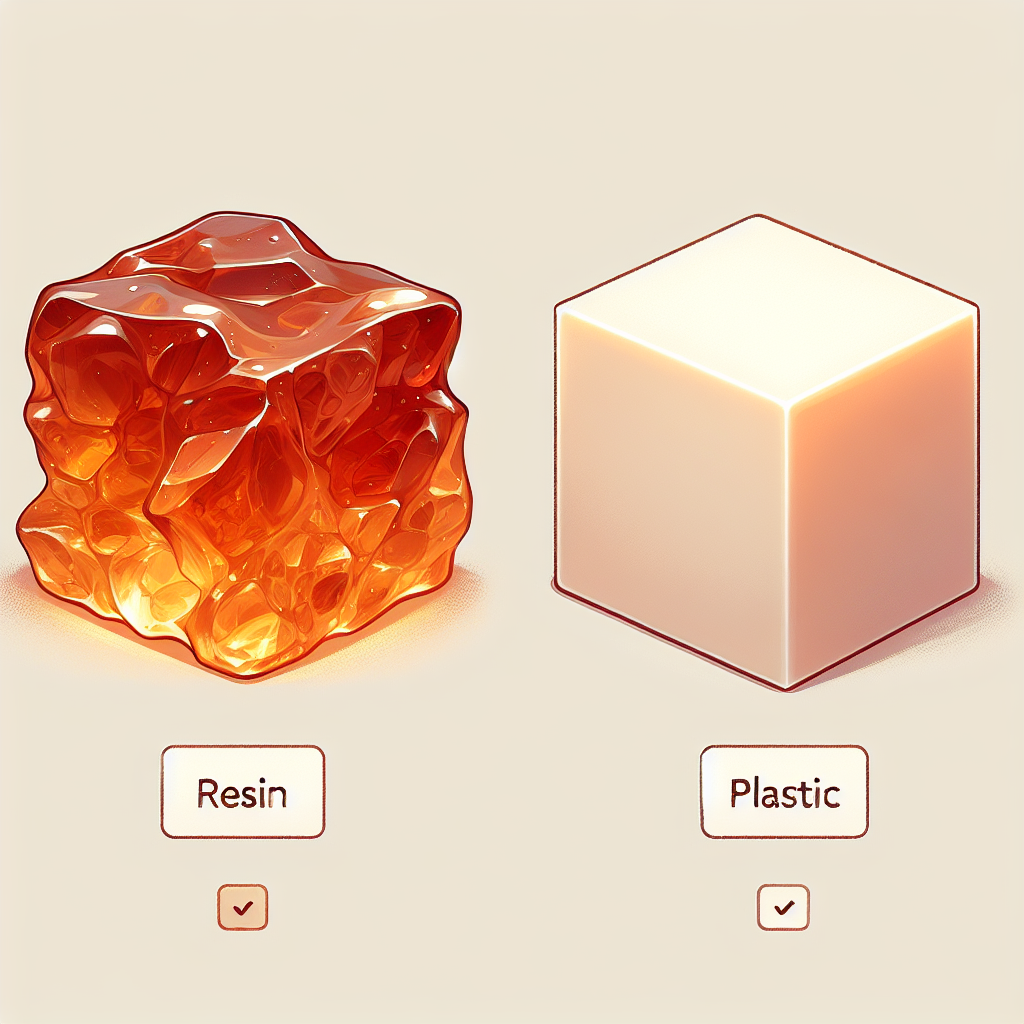Durability: Resin vs Plastic
When considering the durability of materials, the comparison between resin and plastic becomes particularly significant, especially in applications ranging from consumer goods to industrial components. Both materials have their unique properties, which can influence their performance and longevity in various environments. To begin with, it is essential to understand the inherent characteristics of each material. Resin, a versatile substance derived from natural or synthetic sources, is known for its robust structural integrity and resistance to environmental factors. In contrast, plastic, a synthetic polymer, is widely recognized for its lightweight nature and ease of manufacturing.
One of the primary advantages of resin is its superior resistance to wear and tear. This characteristic makes resin an ideal choice for applications that require long-lasting durability, such as in the production of high-quality furniture, decorative items, and even certain automotive parts. The chemical composition of resin allows it to withstand exposure to moisture, UV light, and temperature fluctuations, which can often degrade other materials over time. Consequently, items made from resin tend to maintain their aesthetic appeal and functional integrity for extended periods, making them a preferred option for outdoor use.
On the other hand, plastic, while generally less durable than resin, offers its own set of advantages. The lightweight nature of plastic makes it an attractive option for products that require portability or ease of handling. Additionally, certain types of plastic, such as high-density polyethylene (HDPE) and polycarbonate, exhibit impressive resistance to impact and stress. This resilience can be particularly beneficial in applications such as packaging, where the material must endure various handling processes without compromising the integrity of the contents. However, it is important to note that not all plastics are created equal; some may become brittle over time, especially when exposed to harsh environmental conditions.
Moreover, the manufacturing processes for both materials can significantly influence their durability. Resin can be molded into complex shapes and forms, allowing for a high degree of customization while maintaining strength. This versatility is often leveraged in industries that require precision and durability, such as aerospace and medical devices. Conversely, plastic can be produced in large quantities at a lower cost, making it a popular choice for mass-produced items. However, the trade-off often lies in the long-term durability of these products, as many plastics may not withstand the same level of stress or environmental exposure as resin.
In terms of environmental impact, the durability of a material also plays a crucial role. While both resin and plastic can contribute to waste issues, the longevity of resin products may lead to less frequent replacement, potentially reducing overall waste. However, it is essential to consider the recyclability of each material. Many plastics can be recycled, which can mitigate some of the environmental concerns associated with their use. In contrast, resin products may not always be recyclable, depending on their specific formulation and the presence of additives.
Ultimately, the choice between resin and plastic hinges on the specific requirements of the application at hand. If durability and resistance to environmental factors are paramount, resin may be the superior option. However, for applications where weight and cost are critical considerations, plastic may prove to be more advantageous. By carefully evaluating the intended use and environmental conditions, one can make an informed decision that balances durability with practicality, ensuring that the selected material meets both performance and sustainability goals.
Environmental Impact: Resin vs Plastic

When considering the environmental impact of materials, the comparison between resin and plastic becomes increasingly relevant in today’s eco-conscious society. Both materials are widely used across various industries, yet their environmental footprints differ significantly. Understanding these differences is crucial for making informed choices that align with sustainability goals.
To begin with, it is essential to recognize that plastics, particularly those derived from fossil fuels, contribute significantly to environmental degradation. The production of conventional plastics involves the extraction and processing of petroleum, which not only depletes non-renewable resources but also emits greenhouse gases. Furthermore, the disposal of plastic products poses a considerable challenge, as many types are not biodegradable and can persist in the environment for hundreds of years. This longevity leads to the accumulation of plastic waste in landfills and oceans, where it poses threats to wildlife and ecosystems.
In contrast, resin, particularly when derived from natural sources such as plant materials, can offer a more sustainable alternative. Biodegradable resins, for instance, are designed to break down more quickly than traditional plastics, thereby reducing their long-term environmental impact. These materials can decompose under specific conditions, returning to the earth without leaving harmful residues. However, it is important to note that not all resins are created equal; synthetic resins, like epoxy or polyester, can share similar environmental drawbacks with conventional plastics, particularly if they are not disposed of properly.
Moreover, the production processes for both materials also play a significant role in their environmental impact. The manufacturing of plastics often involves energy-intensive processes that contribute to carbon emissions. In contrast, some resin production methods can be less energy-intensive, especially when utilizing renewable resources. However, the environmental benefits of resin can be diminished if the sourcing of raw materials leads to deforestation or habitat destruction. Therefore, the sustainability of resin largely depends on responsible sourcing practices.
Another critical aspect to consider is the recyclability of both materials. While many plastics can be recycled, the reality is that a significant portion ends up in landfills due to inadequate recycling infrastructure and consumer behavior. On the other hand, certain types of resin can also be challenging to recycle, particularly if they are mixed with other materials or if they have been cured. This complexity can hinder the recycling process and limit the potential for reusing these materials effectively.
In addition to these factors, consumer awareness and behavior play a pivotal role in determining the environmental impact of both resin and plastic. As consumers become more informed about the implications of their choices, there is a growing demand for sustainable alternatives. This shift in consumer preference can drive innovation in both resin and plastic production, encouraging manufacturers to develop more eco-friendly options.
Ultimately, the decision between resin and plastic should be guided by a comprehensive understanding of their environmental impacts. While resin may offer certain advantages, particularly when sourced sustainably, it is crucial to evaluate the specific type of resin or plastic in question. By considering factors such as production methods, biodegradability, and recyclability, individuals and businesses can make more responsible choices that contribute to a healthier planet. As the conversation around sustainability continues to evolve, it is imperative to remain vigilant and informed, ensuring that our material choices reflect a commitment to environmental stewardship.
Cost Comparison: Resin vs Plastic
When considering the choice between resin and plastic, one of the most significant factors to evaluate is the cost associated with each material. Understanding the financial implications of using resin versus plastic can greatly influence decision-making, particularly for businesses and individuals engaged in manufacturing, crafting, or product development.
To begin with, it is essential to recognize that the cost of resin and plastic can vary widely based on several factors, including the type of resin or plastic being used, the quantity required, and the specific application for which the material is intended. Generally speaking, resin tends to be more expensive than standard plastic. This price difference can be attributed to the more complex manufacturing processes involved in producing resin, as well as the higher quality and durability that resin often provides. For instance, epoxy resin, which is commonly used in various applications, is known for its strength and resistance to environmental factors, making it a preferred choice for high-performance products.
On the other hand, plastic, particularly in its most common forms such as polyethylene or polypropylene, is typically more affordable due to its widespread availability and simpler production methods. The mass production of plastic has led to economies of scale, which in turn reduces costs for manufacturers. Consequently, for projects with tight budgets or those that require large quantities of material, plastic may present a more economically viable option.
However, while the initial cost of resin may be higher, it is crucial to consider the long-term value it can provide. Resin products often exhibit superior durability and longevity compared to their plastic counterparts. This durability can translate into lower maintenance costs and a longer lifespan for the final product, which may ultimately justify the higher upfront investment. For example, in applications where products are exposed to harsh conditions or require a high degree of structural integrity, the initial cost of resin may be offset by the reduced need for replacements or repairs over time.
Moreover, the specific application can significantly influence the cost comparison between resin and plastic. In industries such as automotive or aerospace, where performance and safety are paramount, the benefits of using resin may outweigh the higher costs. Conversely, in consumer goods or packaging, where cost efficiency is critical, plastic may be the more practical choice.
Additionally, it is worth noting that the environmental impact of each material can also play a role in the overall cost assessment. While both resin and plastic have their environmental challenges, the growing emphasis on sustainability has led to the development of bio-based resins and recyclable plastics. These alternatives may come with different price points, and their adoption can influence long-term costs related to waste management and regulatory compliance.
In conclusion, the decision between resin and plastic hinges on a careful evaluation of both immediate and long-term costs. While resin may present a higher initial investment, its durability and performance can offer significant advantages in specific applications. Conversely, plastic’s affordability and ease of production make it an attractive option for budget-conscious projects. Ultimately, the choice will depend on the specific requirements of the project, the intended use of the material, and the overall financial strategy of the individual or organization involved. By weighing these factors thoughtfully, one can make an informed decision that aligns with both budgetary constraints and performance expectations.



